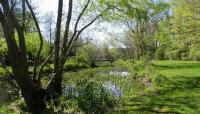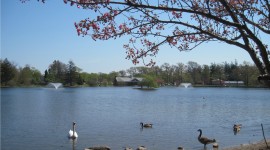Landscape Information
In 1895 Charles Eliot of Olmsted, Olmsted and Eliot was hired to prepare a preliminary plan for the park, on land purchased as important green space in the center of New Bedford. His plan called for enlarging the existing 6-acre pond and creating an expansive meadow along the pond’s edge. Eliot also suggested lawn tennis, ball fields, and a children’s playground, with vehicular traffic limited to a carriage road encircling the proposed site and complimentary footpaths strategically located in the interior. The pond expansion and lawn were partially implemented, but the 97-acre park has continued to develop under many of the overarching principles described in Eliot’s plan. The open lawn with its deciduous trees creates an important central gathering space, while the pond provides opportunities for boating, swimming, fishing, and ice skating. A baseball diamond was laid out in 1896 and tennis courts were built in 1909. The brick Warming House, a 1930s Public Works Project, serves the community as a Senior Center. As early as 1894 the park maintained a small collection of native animals, which has evolved into the 10-acre Buttonwood Zoo. More than 250 new trees have been planted in recent years, to expand the Arboretum and buffer the edges of the park. Buttonwood Park was listed on the National Register of Historic Places in 2000.
















